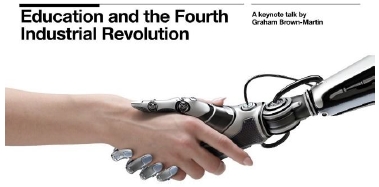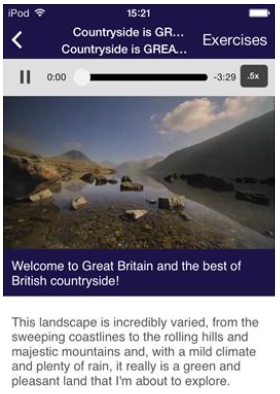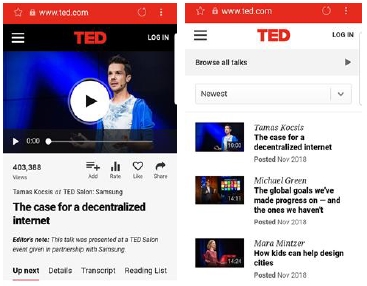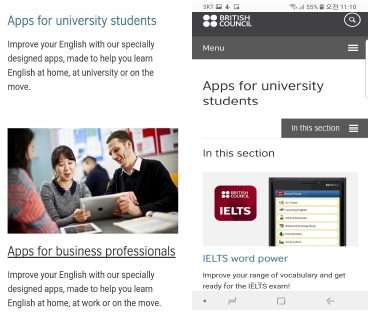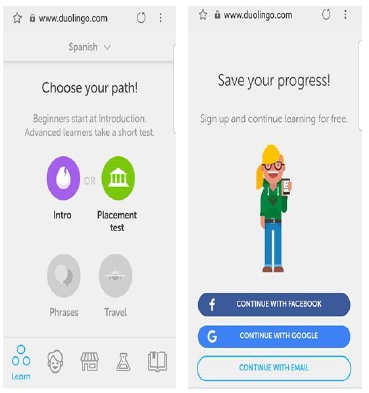
Mobile English Reading and Application Convergence Creativity
Copyright ⓒ 2018 The Digital Contents Society
This is an Open Access article distributed under the terms of the Creative Commons Attribution Non-CommercialLicense(http://creativecommons.org/licenses/by-nc/3.0/) which permits unrestricted non-commercial use, distribution, and reproduction in any medium, provided the original work is properly cited.

Abstract
Due to advances in technologies such as artificial intelligence, big data, biological technology and the Internet of Things (IoT), economic, cultural and social realities have changed rapidly. Education systems and programs must also be reconfigured in the wake of this Fourth Industrial Revolution. This study aims to verify the creative development which is essential for the fourth Industrial Revolution by researching mobile English reading and writing. First, the education of creativity in developing human creative talents is the first step toward preparing for the fourth industry. Second, various English reading immersion studies are very effective in cultivating creative thinking skills. Third, using English learning applications such as TED Talks, Awabe and Duolingo, or studying by software and Internet learning tools is effective for the development of creativity in English writing. Various mobile English reading allows learners to develop their own creativity while thinking, imagining and feeling on their own.
초록
과거에는 인공지능, 빅 데이터, 생물학적 기술, 그리고 사물 인터넷(IoT) 등 기술의 발전으로 인해 경제적, 문화적, 사회적 현실은 급속히 변화되고 있다. 이러한 4차 산업혁명 시대를 맞이하여 교육 시스템과 프로그램 또한 재구성되어야 한다. 본 연구는 모바일 읽기 교육 연구를 통해 4차 산업에 필요한 독창성 개발에 대한 효과를 검증하고자 한다. 연구결과는 다음과 같다. 첫째, 인간의 창조적 재능 개발을 위한 모바일 영어 쓰기 창의성 교육은 4차 산업을 준비하는 첫걸음이다. 둘째, 다양한 영어 읽기 몰입 학습은 독창적이고 창조적인 사고 능력을 배양하는데 매우 효과적이다. 셋째, TED Talks, Awabe, Duolingo 등의 영어 어플과 소프트웨어와 인터넷 학습 도구를 이용한 학습 방법은 영어 읽기 학습에 효과적이다. 다양한 모바일 영어 읽기를 통해 학습자가 스스로 생각하고 상상하고 느끼면서 자신만의 독창성을 개발할 수 있다.
Keywords:
Artificial intelligence, the fourth industry, Mobile reading, Internet tools, Creativity Development키워드:
인공지능, 4차 산업, 모바일 읽기, 인터넷 도구, 독창성 개발Ⅰ. Introduction
There is a strong impact expected from the fourth industrial technology on the way people live, and even on the way students study and acquire knowledge. Though discussions on the dawning of the fourth industrial revolution have begun, the infrastructure has failed to adapt correctly to technological development and its impact on our business and social lives.
<Figure 1> shows that students should have the ability to constantly learn about rapidly changing skills and adapt to cultural, economic, political and social developments in the rapidly changing learning and working environment.
The Boston Consulting Group said that from an economic and industrial standpoint, it is necessary for companies to adopt new work and organizational models, retrain employees, and recruit employees for the fourth industrial revolution.
Alvin Toffler(1970) said that the illiterate of the 21st century are not people who are uneducated or unschooled, but those who are untrainable, those who do not want to learn, or those who do not want to learn new skills[1]. The importance of creativity education is emerging as an alternative to preparing for the fourth industrial revolution.
The purpose of the creative education is to develop creative thinking skills through flexible thinking, which are difficult for robots to imitate. As shown in <Figure 2> reading using various English applications is essential to develop creativity in the era of modern technology society.
Moorman 1994 looked at middle school students to see if the relationship between the discovery of problems in art and creativity in the final product emerged in the writing field[12]. Students who spent more time on finding problems during the pre-writing phase were found to have higher originality scores in writing than students who did not.
Everatt 1999 also found that the ability of fifth grade elementary school students to spot problems has a significant bearing on a child's creative drawing score[5]. Mansfield & Busse, 1981 said that problem discovery plays a crucial role in scientific creative achievement and sensitivity in selecting research problems sets the standard for distinguishing creative scientists from those who do not.
This study aims to show that reading is a necessary method of instruction in this age of the Fourth Industrial Revolution to develop creativity that is essential to future human beings. Reading English is very effective in developing creativity. Reading various writings is also a starting point for good writing. The breadth and depth of things that many readers own can be a basis for creativity and an important tool for overcoming the world.
In order to verify the effectiveness of English reading learning, a group of 100 students were distributed to the experimental and control groups, and the pre-assessment, post-assessment, and satisfaction surveys were conducted. This is to verify the effect of reading learning using applications such as TED Talks, Hello English, and Dulingo by analyzing the results in pre and post-assessment of students in experimental and control groups. In addition, through a survey of students in a group of experiments, new educational content will be presented based on the satisfaction survey.
Ⅱ. Review of Literature
2-1 Fourth industrial revolution and creative education
When the world had great social, economic and technological changes, people used the word "industrial revolution." In each era of the Industrial Revolution, people's abilities to be required were different depending on the characteristics of emerging technologies.
Creative thinking is the ability to detect and guess problems, generate new ideas, and communicate results. Harris(1990) suggested that creative potential for creativity exists in everyone and can be improved through learning. Based on this concept, King(1996) has encouraged learning activities for creativity, particularly through reading and writing[6][9].
<Figure 3> shows a good example of creative potential in human beings. Thinking ability is closely related to language development. Creative thinking has a constant association with literacy. According to the literature (Sturgel, 2008), creativity is linked consistently with the ability to read and write.
Wang (2012) also found that although there is a significant and positive correlation with creative ability and English reading and writing scores when examining the relationship between test scores in other subjects, it is not related to math scores[15].
Some studies of children (Branowsky and Botel, 1974, Ugur Sak, 2004) supported fostering creativity through classroom reading and writing activities. Chen(2005) and Zachopoul(2006) proposed designing the creative process through a variety of learning activities, including reading and writing by university students[2][3].
Teachers should continue to learn the skills and capabilities required to apply and use current and new technologies in the changing essential learning processes and environments. Future education needs to focus on ICT and future technology, teacher training and lifelong learning for adaptive and flexible education systems.
2-2 Reading and creativity
McCrae,(1987) defined creative thinking as the ability to identify, speculate, produce new ideas, and deliver results[11]. As Duffy (1998) suggested, creative thinking is the ability to view things in a new and original way, learn from experience, think in a non-traditional and unique way, and use a non-traditional approach to solve problems[4].
<Figure 4> shows mobile English reading application which students may use from the web site of British council. Reading and writing are intuitively linked to creative thinking. This is mainly because reading and writing are often critical, analytical, self-expression skills and a sense of self-discovery. Reading becomes a rich resource for developing creative ideas.
PopovMcVeigh (1993) explains that any kind of writing is creative in itself and that reading and writing education should be important for endless creation possibility. The need for a curriculum for reading and writing activities was also mentioned to encourage students' creative education[13][3].
While reading, students use their imagination without even knowing it, and through the process, their original imagination is actively stimulated and activated. Therefore, given the imagination that letters stimulate people, it has become a new necessity that to live in the fourth industrial era is to read through letters.
Ⅲ. Direction of digital converged English education
Many people have the same smart phone, but experience varies depending on which application you use. In such a situation where each person has completely different experiences with the same product, creative ability is required. <Figure 5> shows a relationship between robot and human.
In such a society where creativity is required, creative ability can be expressed through new methods. Only creative ability guarantees survival. In order to become a man with creative and complex problem-solving skills, the ability to recognize problems that are not uniform, to derive alternatives that combine the values of diversity, and the ability of collaborative communication are required.
3-1 Creative convergence learning
In the fourth industrial era, educational goals can result in the fostering of creative convergence personnel. The Education Ministry announced the slogan "to combine diverse knowledge with the ability of humanities to create science and technology" during the 2015 revision. To this end, a variety of educational forms and methods are presented to foster creative and converged talent at school sites. But it is not easy to change deep-rooted education.
Discussions with foreigners in a foreign language may give students the opportunity to apply and integrate disparate materials and cultures. A foreign language can be a tool for developing the ability to integrate creativity. Learning a foreign language is not just about learning the ability to understand meaning. Language is a means of expressing the thoughts and thoughts of the speaker. Language training will inevitably involve thought training.
A faithful language activity (reading, speaking, and writing) is important. Students need to read various fields such as science and humanities to find a basis for convergence. In order to develop the ability to integrate creativity, it is important to engage in activities that discuss and use based on what they read.
3-2 Reading and writing creativity
The level of the essay is ultimately determined by creative thinking. Of course, to think creatively, students need the background and thinking power of writing. Grammar and spelling do not determine the level of writing. A student's writing, who has thought about the subject or read a book on the subject, is bound to differ from the writing of a student who has never read or even thought about it.
Creative thinking is not made overnight. Students who have developed a habit of reading and thinking from an early age can have fresh ideas. Grammar and spelling can be easily corrected, but cultivating your ability to think takes time.
To write a good essay, students should read a lot of books and think about it. If a student wants to foster originality through reading, it is necessary to start reading critical books. Instead of accepting the story as it is, they think about what the author wrote. It is also necessary to train the author to approach the book through critical thinking that his ideas are not always right.
Writing can be creative if students have a lot of thoughts on a given subject, and if they don't think much about it, it won't be original. Therefore, the originality of writing can be gained from their deep and rich thoughts through reading.
3-3 Mobile English reading applications
Reading English is available in newspapers, autobiographies, novels, poetry, digital e-books, but the easiest way for learners to access them is by mobile reading. In this study, it will be explored how to learn English reading through various mobile applications.
The first application which can be applied in this paper is TED Talks. It is useful to look at how to learn English by using the free mobile app for Android and iOS, which can improve English reading learning. The biggest advantage of TED Talks is that they can cover interesting topics. The TED video includes a speech that students can follow whenever they hear the subject of interest of the world's greatest speakers.
<Figure 6> is a scene from TED Talks where students can select areas of interest from a list of topics, and they can also choose people they talk to and learn from mobile. Naturally speaking English is one of the efficient ways to increase reading comprehension.
<Figure 7> shows the application of LearnEnglish, which is managed by Engish Council. Students can download LearnEnglish applications from mobile phones and tablets. They are asked to download Android, iPhone and iPad applications to learn with Android programs.
The LearnEnglish Podcasts application is an English Learning Podcast series that allows students to practice English on their mobile phone while on the go. A series of short videos about British culture can be used to visit museums and other popular sites in the United Kingdom.
The most popular English learning iPodcast series in the British Cultural Center, LearnEnglish Podcasts, can be studied as a mobile device. The application helps you learn everyday English by providing 20 hours of free listening to over 80 episodes and new features to help you listen and understand a wide range of conversations. Entering each episode, you can chat with different people, such as Podcast host Tess, Ravi, Adam and Rob, to talk about your favorite celebrities, weekend planning, dinner parties, and city residences.
<Figure 8> shows UK life episodes. All episodes can be heard and read with moving listeners. The audio script is highlighted so that students can concentrate on listening. Reading problems can be seen in each episode to confirm that students understand the conversation.
If students want to learn English from the start, as shown in <Figure 9> the Duolingo application is the best one. Duolingo can learn up to 23 languages, including English, by using interactive games. Applications for beginners focus on learning verbs, phrases, and sentences. Advanced users can also improve their learning skills through writing, speaking, and vocabulary lessons.
To start the learning process, students may choose the language and native language they want to learn. Then students can check whether they want to learn a language from scratch or take other steps. This test is necessary to verify learners' language skills. Duolingo provides appropriate learning materials based on test results.
This paper is to study how to learn using various Apps to improve reading comprehension in English through the development of the Internet and IT. Each attribute should be considered carefully in order to find apps that match student’s learning objectives. If students use the English app to read American history, culture, politics, and current events, they can read them through mobile.
Ⅳ. Creativity effect analysis
In the fourth industrial era, the area that artificial intelligence of information and communication convergence cannot affect is the area of creativity. The most important education to foster creativity is creativity education. The ability to integrate with creativity begins with reading various books. This paper investigates the effects of mobile English reading through various applications on how much it affects the creativity of writing.
4-1 Subjects
This study is to validate the learning effects of mobile reading through an English app on the creativity of writing. In particular, reading English can be a tool to foster creative convergence. Creativity is developed through reading and thinking about various materials, expanding and writing information directly. Creative ideas also come to mind in the process of writing various ideas.
The objects of this study were pre and post-assesment, dividing 100 students at D University into experimental and control groups. To verify the objective learning gap between the experimental groups and the control groups, a reading and writing assessment was conducted on all students before the experiment. A prior assessment was conducted to ensure accurate achievement analysis and homogeneity testing between the two groups.
As shown in <Table 1>, mobile English applications such as TED Talks, UMANO, and LearnEnglish Podcasts were applied to learning English mobile reading. The mobile English application has interested students and made self-directed learning possible in various readings.
The following hypotheses were set up for the verification of creativity after a semester class of experimental groups using mobile English apps such as TED Talks, UMANO, and LearnEnglish Podcasts.
- (1) Hypothesis 1: A difference is revealed in the level of writing learning achievement of the two groups after the experiment.
- (2) Hypothesis 2: A difference is also demonstrated in the performance of the writing creativity of the students of experiment group after the experiment.
- (3) Hypothesis 3: After an experiment, reading English using the TED Talks, Umano, and LearnEnglish Podcasts applications has a positive effect on the development of the creativity of writing.
4-2 Research methods and process
While writing classes were given to students in experimental groups and control groups, the students in the experiment group were given English-language reading tasks through the app, while students in the control group were given writing tasks centered on writing materials to conduct the classes faithfully.
As shown in <Table 2>, the experimental group has a pre-assessment average of 66.86 while the control group has a pre-assessment average of 67.38. The standard deviation of the control group is 14.112. The correlation coefficient for the two groups is –0.022; the t-test value is –0.175; and the p value is 0.862.
After one semester of these classes, a post-assessment was conducted to analyze whether the classes were effective in fostering the creativity of writing through various English reading tasks. In addition to the pre-assessment, a number of surveys were also conducted to ensure that the English reading task using the English app was effective in fostering written creativity.
Reading tasks using the English Duolingo app used interactive games to guide students to participate in tasks with interest and curiosity in reading English. A number of materials were read to familiarize themselves with verbs, phrases, and sentences, and then summarized in writing class.
The English app Umano is an English news-readable app. Students were asked to read the news by selecting topics of interest from various lists. They also shared the article they were reading with their friends on social networking sites to share information and read it together. After talking about an article with their friends in writing class, they were asked to add their own thoughts to write in summary.
The LearnEnglish Podcasts app, the most popular English learning series in the British Cultural Center, is available for reading and listening through mobile devices. Through the app, students chose interesting episodes. Also, after the reading, they were asked to chat with the organizers or other people about their feelings. They also downloaded episodes on mobile and read them whenever they had time.
This study was organized and studied to analyze the effects of creativity development in writing classes based on the survey of the control group students and students in the writing group who assigned various data reading tasks through these English applications.
4-3 Research results
The results of the study are gathered from six-month lesson and evaluation results to ensure that there is no point error between the experimental groups and the control groups by conducting the preceding assessment for 100 students. The controlled group that participated in the writing class was given writing tasks, while the experimental group was given various reading tasks using the English app. In the six-month writing class, the performance of write creativity was analyzed through pre- and post-assessment.
Prior assessment was conducted to divide into experimental and control groups just before the semester class, and post-assessment was performed in the last week of the semester. The pre-assessment score of the experimental groups conducted at the beginning of the semester is 66.86 while the average of the control group is 67.38.
However, the average of the experiment group was 77.4 in post-assessment, while the average score of the post-assessment for the control group was 72.5. And a 4.9 difference in average scores between both groups was shown. These results prove that after 6 months of writing lessons, the average of the experiment group is higher by 4.9 points compared to the control group. These results are expected to have a different average score between the two groups in long-term learning and show greater effectiveness in developing the creativity of written learning.

Pre and post assessment of experiment groupHigh Group(t=-6.775 df=16, p=0.000). Middle Group(t=-16,703, df=16, p=0.000). Lower Group(t=-26.854, df=15, p=0.000); C/C = correlation coefficient
The results of the pre-assessment of the experiment group were 66.86 but the post-assessment was 77.4, improving the score of 10.54. This means that English reading learning through English applications was effective in developing English writing creativity. On the other hand, the control group scores 72.5 points in an English writing creativity test through the control group's English writing assignment. Reading English applications has enabled students to understand themselves better and to increase their critical thinking skills through reading. Therefore, the results of the group's evaluation show that classes for developing future write creativity were more effective than classes for students to practice writing only through various reading.
A survey was conducted on students in a group of experiments to see if reading learning through an English app was effective in developing the creative abilities of writing. First of all, mobile English reading learning is effective in developing English writing creativity, according to a survey.
As shown in <Table 5>, 50 students from the experimental group who participated in write creativity were surveyed to see if mobile English reading learning was effective in developing English writing creativity. Twenty-three out of 50 students said they were very effective, accounting for 46 percent. Also, 18 students, 36%, answered that they were effective, and 9 students said the effect was normal. What this table shows is that there is not a single student who doesn't think mobile English reading learning can help develop write creativity.
The second survey of the students was on whether the reading experience helped them create new ideas. The creativity of reading has come to this question on the assumption that reading stories of experiences or autobiographies can enrich one's imagination. Reading books based on experience can be a good start to creativity.
What <Table 6> implies is that students are fully supportive of being able to feel their thoughts and create new ideas through writing about other people's experiences. The number of students who answered that reading English is very effective in creating new ideas is 17 with 34 percent of the total respondents. In addition, 19 students with 38% answered "effective," 13 students with 26% answered "average". However, only one negative response was given, which accounts for only two percent of the total, suggesting that reading helps create new ideas.
The final survey was on whether mobile English reading became the basis for critical thinking and thinking skills of students in writing classes. <Table 7> shows that the number of students who answered "very well based" was 18, 36% of the total respondents, while those who answered "help" were 21, 42% of the total respondents; those who answered "normal" were 18% with 9 students. The percentage of negative response was 4 percent with 2 students, but 39 students answered that reading mobile English became the basis for critical thinking and thinking. This was a very positive response from 78 percent of the total respondents, which shows that it is possible to write their original, distinct writing considering the author's intent to write.
The experimental groups and control groups have analyzed the pre and post assessment of the effects on the development of English writing creativity through mobile English reading learning. The post-assessment of the experiment group showed that the test group's students performed better than the control group. In addition, the improved scores of 10.54 were found when comparing the scores between the prior and post-assessment of experiment group.
In addition, more than 70 percent of the total respondents responded very positively to the effects of reading mobile English books to develop creativity. The results of these surveys also show the importance of mobile English reading learning to develop English-language writing creativity together with the results of the pre and post assessment surveys.
Ⅴ. Conclusion
Education in the fourth generation of industrial revolution has been an urgent problem in modern education. The education system and programs need to be discussed on how to relate to the fourth industrial revolution, and how to restructure our education system for such preparations.
This research was intended to present educational goals for fostering future human resources in the 4th Industrial Revolution era. The development of artificial intelligence robots has led to the development of creative and integrated human resources that can develop human potential.
Language education, such as reading and writing, is necessary to foster the ability to integrate creativity. This is because creative thinking comes to mind in the process of writing various ideas. In order to think about various things, students will have to read various fields such as science and humanities before integrating them. To develop the ability to integrate creativity, creativity is developed through discussion based on what is read and writing.
To verify the creativity of writing, mobile English reading was introduced in English writing classes to analyze the effectiveness of writing creativity. The number of 100 students were divided into experiment group and control gourp. The two groups' pre-assessment and post-assessment were conducted to validate the creative effects of the writing classes by comparing the scores between the two groups and analyzing the prior and post-assessment of the experimental group.
The results showed that the writing creativity score of the experiment group's students was higher than the creativity score of the control group, as indicated in the post-assessment. In addition, the experiment group's pre-assessment was 66.86, but the average score for the post-assessment was 77.4, showing an improvement of approximately 10.54. This shows that learning to read English was effective in developing English writing creativity.
In addition, several surveys were conducted on experiment group students to analyze the effects of developing creativity in English writing classes. As a result, more than 70% of all respondents will benefit from the experience gained from positive reading in the survey and help create new ideas. Mobile English reading learning is effective in developing English writing creativity and helps create new ideas based on the experience gained from reading. Reading English books also provided a foundation for critical thinking and thinking skills.
This shows that in order to compete with artificial intelligence robots in the era of the fourth industrial revolution, future human beings need to shift their thinking to foster creative, integrated talent, instead of learning English, which is based on memory.
English education in the 4th Industrial Revolution era should be reorganized into a curriculum for creativity, beyond just entrance education, grammar and reading education. First, the ability to communicate through understanding each other's culture and values beyond seamless communication. Second, it should be a creative convergence education applied with modern technology. Third, to foster creativity, students should share the knowledge and experience of the writer and the main character through various reading and create new knowledge.
References
- Alvin Toffler, “Future Shock”, Bantam Books, ISBN 0-553-27737-5, (1970).
- Branowsky, A., & Botel, M., “Creative thinking, reading and writing in the classroom”, Elementary English, 51(5), p653-654, (1974).
- Chen, CW., “The Creative Process of Computer–Assisted Composition”, Doctoral dissertation, University of Missouri, (2005).
- Duffy, Bernadette Duffy, “Supporting Creativity and Imagination in the Early Years”, Open University Press, (1998).
- Everatt, J., Steffert, B., & Smythe, I., “An eye for the unusual: Creative thinking”, Dyslexia, 5, p28-46, (1999).
- Harris, A. J., and Sipay, E. R., “How to Increase Reading Ability: A Guide to Developmental & Remedial Methods”, Longman, New York, ninth edition, (1990).
-
Hyeon-yoeng Lee, Jong-seok Lee, Byeong-do Kang, Seung-weon Yang, “Functional Expansion of Morphological Analyzer Based on Longest Phrase Matching for Efficient Korean Parsing”, Journal of Digital Contents Society, 17(3), (2016).
[https://doi.org/10.9728/dcs.2016.17.3.203]

-
Irma Sturgell, “Touchstone Texts: Fertile Ground for Creativity”, The Reading Teacher, 61(5), p411-414, (2008).
[https://doi.org/10.1598/rt.61.5.5]

-
King, L. A., Walker, L. M. K., & Broyles, S. J., “Creativity and the five-factor model”, Journal of Research in Personality, 30, p189-203, (1996).
[https://doi.org/10.1006/jrpe.1996.0013]

-
Mansfield, R. S., “Theories of the creative process: A review and a perspective”, The Journal of Creative Behavior, 14(2), p91-103, 132, (1981).
[https://doi.org/10.1002/j.2162-6057.1980.tb00232.x]

-
McCrae, R. R., “Creativity, divergent thinking, and openness to experience”, Journal of Personality and Social Psychology, 52, p1258-1265, (1987).
[https://doi.org/10.1037//0022-3514.52.6.1258]

- Moorman, K., and Ram, A., “A model of creative understanding”, In Proceedings Twelfth National Conference on Artificial Intelligence, (1994).
-
Popov, A., “Creativity and reading comprehension”, Journal of Creative Behavior, 26(3), (1993).
[https://doi.org/10.1002/j.2162-6057.1992.tb01177.x]

-
Ugur Sak, “A Synthesis of Research on Psychological Types of Gifted Adolescents”, The Journal of Secondary Gifted Education, XV(2), Winter (2004).
[https://doi.org/10.4219/jsge-2004-449]

-
Wang, A. Y., “Exploring the relationship of creative thinking to reading and writing“, Thinking Skills and Creativity, 7, (2012).
[https://doi.org/10.1016/j.tsc.2011.09.001]

- Selected Jean Piaget Resources http://www.questia.com/Index.jsp?CRID=jean_piaget&OFFID=se1
저자소개

1997 : Department of English Literature, Dankook University(Master)
2005 : Department of English Literature, Dankook University(Ph.D)
2009∼Present : Associate Professor, Generation Education, Dankook University
Interesting Area: Digital Contents, Language Communication, E-learning, Computer interaction
